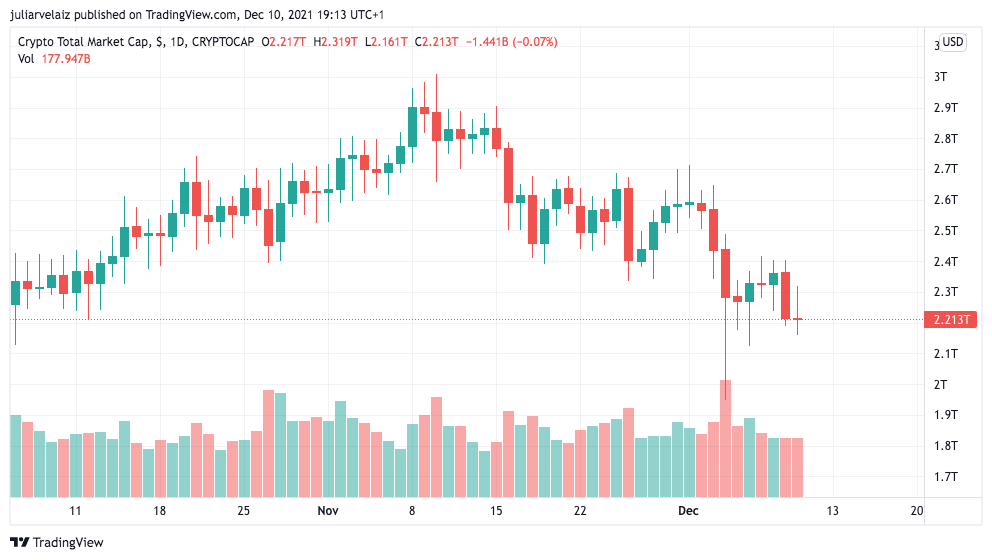What An IMF Crypto Global Regulatory Framework Looks Like
The International Monetary Fund (IMF), in an effort to create a global regulatory framework for crypto, has proposed an outline.
As the institution thinks that “Uncoordinated regulatory measures may facilitate potentially destabilizing capital flows”, they hope for an international guideline to assess possible risks and diminish the general lack of clarity.
The IMF’s mandate is to safeguard the stability of the international monetary and financial system, and crypto assets are changing the system profoundly.
The IMF sees many of the benefits that come from the innovative virtual assets industry, but it also sets its eye on the market’s volatility. At the moment, the total market capitalization looks red amidst a sell-off that possibly follows fears of the Omicron variant and the U.S. imminent taper.
The institution worries cryptocurrencies’ volatility ” might also reflect froth in an environment of stretched valuations.”

The IMF blog points out that many cryptocurrency-related activities remain unregulated and policymakers are struggling to monitor “financial stability risks”, which they think could become “systemic in some countries.”
Such risks underscore why we now need comprehensive international standards that more fully address risks to the financial system … while allowing for an enabling environment for useful digital asset products and applications.
Beyond determining valuation, the financial institution thinks the digital assets ecosystem presents other challenges like “identification, monitoring, and management of risks” that “defy regulators and firms.” This would call for a need to supervise cryptocurrency exchanges and wallets to identify integrity risks, “inadequate reserves and inaccurate disclosure for some stablecoins.”
The IMF worries the digital assets boom brings the increase of ‘cryptoization’ in developing countries –”a step too far”, they think–, which is the term for “when these assets replace domestic currency”, finding ways to go around exchange restrictions, and the countries’ balance of payments.
Related Reading | Biden Administration Drafting Bitcoin Regulation, Why It Could Be Approved Soon
Cross-border Supervision Of Crypto?
The IMF calls for The Financial Stability Board, which coordinates “the development of regulatory, supervisory and other financial sector policies”, to create “a global framework comprising standards for regulation of crypto-assets” with the objective of providing a path to manage the said “risks to financial stability” and deceptive acts.
This path should be able to get implemented by all jurisdictions to further diminish possible regulatory arbitrages. They see this as a “daunting task”, but hope that starting now could secure financial stability and benefits from the remarkable “technological innovations”.
The institution sees the regulatory approach offered by separate nations –undertaking different strategies– as “limited” in front of digital assets’ cross-border transactions. They think it is a difficult task to supervise virtual assets service providers who operate in separate countries, and the existing laws and regulations may be far from covering cross-border remit.
Standard-setting bodies responsible for different products and markets have provided varying levels of guidance … While useful, these efforts aren’t sufficiently coordinated towards a global framework for managing the risks to financial and market integrity, financial stability, and consumer and investor protection.
As the cryptocurrency ecosystem is deeply evolving the financial system globally, the IMF outlined three elements for “a level playing field along the activity and risk spectrum”:
- Crypto-asset service providers that deliver critical functions should be licensed or authorized.
- Requirements should be tailored to the main use cases of crypto assets and stablecoins.
- Authorities should provide clear requirements on regulated financial institutions concerning their exposure to and engagement with cryptocurrencies.
Related Reading | The Biggest Cryptocurrency Headlines In November
OhNoCryptocurrency via https://www.ohnocrypto.com/ @Julia Arvelaiz, @Khareem Sudlow
